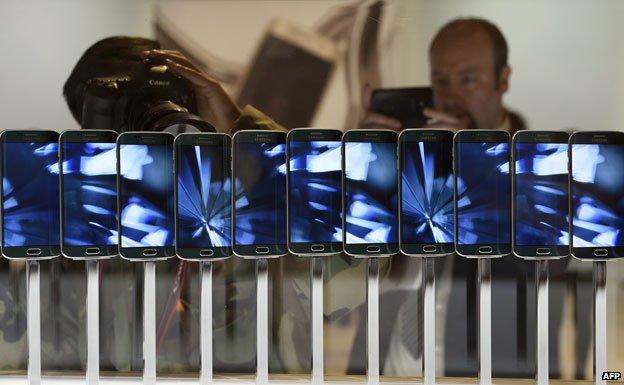Samsung tries to get an edge on its rivals
- Published
- comments
Rory Cellan-Jones tries out the Samsung S6 handsets
The world's mobile phone makers, gathered in Barcelona this week, have a guilty secret - they know full well that all of their latest models look roughly similar and do much the same as those of their rivals. And for the world's biggest phone maker Samsung that's a problem - it needs to look different.
Faced with the mighty brand of Apple's iPhone at the top end of the market and Chinese models that are now offering a smartphone experience at a bargain price, the South Korean giant has had a tricky year. At the end of 2013, it had a big lead over Apple in the smartphone market, but by the final quarter of 2014 the two firms were neck-and-neck, and three Chinese firms, Huawei, Lenovo and Xiaomi, together made up a powerful third force.
Last year's version of its flagship phone, the Galaxy S5, had failed to produce too much excitement even amongst the firm's most loyal fans. So a lot was hanging on Sunday evening's Galaxy Unpacked event held in the biggest arena I've ever seen for a mobile phone launch.
WATCH: Rory Cellan-Jones reports from Barcelona on Samsung's new phone
And Samsung did indeed have something that looks radically different, the Galaxy 6 Edge. Its glass screen wraps around the sides of the handset and is used to deliver notifications, and as an area where your closest contacts are kept - so for instance the screen edge might light up green when it's your boss calling
The other new model the Galaxy 6 isn't so radical, but like the Edge it has a more solid and luxurious feel than its predecessors. Or to put it bluntly, it is less plasticky - because its back cover isn't plastic. That was the main criticism of the S5, but replacing it with Gorilla glass comes at a price. Gone are the removable battery and storage which many Samsung fans always saw as a major advantage over Apple's iPhone.
But, just as Apple was finally forced to imitate Samsung in offering bigger screens, so the Korean firm has had to accept that sometimes design is a bigger attraction to consumers than convenience. Besides, says Samsung, our new phones charge much faster than the iPhone, so no need to remove the battery.
"We've learned from our missteps, we've listened to consumers," was the message repeated to me by several Samsung executives - though getting them to explain exactly what those "missteps" were proved tricky. What they did seem focused on was proving that they can now match Apple for design and surpass the iPhone when it comes to the camera. Quite some time was spent comparing photos taken on the S6 and the iPhone 6 Plus - and guess which came out best?

Meanwhile, across town, one of the Chinese rivals that is hurting Samsung was setting out its store. Huawei, now not just a boring telecoms equipment giant but a growing force in smartphones, was unveiling its first smart watch to add to its growing stable of wearable devices. The Huawei Watch, which runs on the Android Wear software, is a rather more handsome device than any so far produced by Samsung.
Across the technology industry, companies are waking up to the fact that looks really matter. Not only will an ugly device not sell, it can seriously damage your brand. Samsung's good looking new smartphone should restore some of its lost confidence - but you can bet a Chinese firm will be along soon with an even edgier device at half the price.